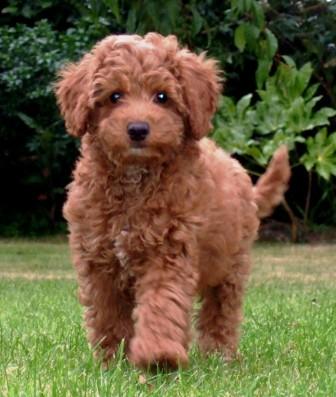Breed Standard
General Appearance
The Australian Labradoodle moves with agility and grace when active yet is compact with substance and medium boning. Brimming with joy and energy when free, they become relaxed and quiet when handled. Australian Labradoodles have a free flowing wavy or curly coat that is low to non-shedding. Early generation Labradoodles used for infusion have greater variability in coat.
Temperament
The Australian Labradoodle is naturally social and bonds well with their human companions. Overflowing with joy and fun, they bring endless amusement and happiness to those around them. The Labradoodle is intuitive and intelligent, showing exceptional love and loyalty to those with special needs. Easily trained, the Labradoodle is an ideal companion for families of all kinds.
Size
There should be no appreciable difference in the general appearance of the Standard, Medium, or Miniature sizes except in the actual size difference. Approximate weight can range from 15 pounds to 65 pounds. Height is measured to the top of the shoulder blades (withers) while standing squarely on a level surface.
Miniature – Height: 14 to 16 inches (not over 17) 35cm to 43cm
Medium – Height: 17 to 20 inches (not over 21) 43cm to 53cm
Standard – Height: 21 to 24 inches (53cm to 63cm)
Note: Service dogs bred for mobility support may be larger than the breed standard.
Faults
• Any sign of aggression or dominance (major fault)
• Fearful, timid, yappy or highly-strung temperaments
• Short or overly thick neck
• A coat that sheds like a hair coat in a multi generation dog
• A long, narrow head
• Protruding or sunken eyes
• Watery or tearful eyes
• Over or underbite
• Long back
• Bad carriage or heavy gait
• Cow hock
• Toeing in or out
• Albinism (disqualification)
Head
Head should be moderately broad with eyes set well apart, without exaggeration. The head should be fully coated as on the body, legs and tail. It should be in proportion to the size of the dog and should flow naturally into a muscular neck.
Skull should be slightly rounded, not domed. Muzzle should be more squared than pointy. Nose should be large, of square appearance and fleshy.
Scissor bite is most desirable, with upper teeth just overlapping bottom teeth.
Eyes should be large, expressive and slightly rounded. Eye colors can be darkest brown, a transparent honey colour, or shades of hazel. Kind, friendly eyes imparting good temperament, intelligence, intuitiveness and alertness are a hallmark of the breed.
Ears should lay flat against head in proportion with the skull with a slight lift at the base for air flow and set slightly above eye level. Leather should be of medium thickness and should not hang below the lower lip line.
Neck, Topline, Body
Neck is well-proportioned, of good strength and moderately long, slightly arched and flowing into shoulders with no appearance of abruptness.
Shoulder blades and upper arms should be the same length. Shoulders should be laid back with elbows set close to the body.
Forelegs should be straight when viewed from the front.
Hindquarters should be well-muscled for power in movement. In profile, the croup (buttocks) is nearly flat, though slight sloping is acceptable.
Stifles (knee joints) should be moderately turned to propel forward movement, and hock (ankle) to heel should be strong, short and perpendicular to the ground. View of legs from the rear should appear parallel.
Tail should be long and not too thin, following the top line when in repose or may be carried high in a happy or lively manner when in motion. Curly tails are acceptable, but tails that curl over onto the back are not the ideal.
Feet are of medium size, round with well-arched toes having elastic and thick pads. The feet should not turn in or out.
Top line should be level. Height (to shoulder) as to length (from shoulder to point of buttock) should appear square and compact.
Loins should be strong and muscular with moderate tuck up. Ribs should be well sprung but not barrelled.
Overall, the dog should appear square, be balanced, athletic and with good muscling.
Movement
Trotting gait is effortless, smooth, powerful and coordinated in mature dogs. Should have a good reach in front and drive from behind for flowing, well-balanced forward motion. When trotting or galloping, they should appear to float almost above the ground. Light and airy, free moving with no apparent effort.
Coat
The ideal in the Australian Labradoodle is a low to non-shedding coat; however, because the breed is still evolving, it is common to see more than one coat type in the breed.
Australian Labradoodles have a single coat ranging from straight to lose curls or wool. Ideally, the curls should not be tight, and the coat should not be too thick or fluffy. They can be allergy friendly to many people who have dog related allergies. The coat is as non-shedding as any dog can be. However, in some of the early generations, F1, F2 and F1b, more shedding can occur, but shedding is rarely seen in the multi generation Labradoodle.
Texture—there are three types of texture:
• The hair coat sheds a light to moderate amount. This coat is seen in early generations.
• The wool coat is dense and similar in feel to a lamb’s wool. Wool coats hang in tight or loose spiralling curls and will open to show the skin. It is low to no shed.
• The fleece coat has a silky texture often described as an Angora goat texture. This coat ranges from straight to wavy or falling in soft curls. It is low to no shed.
Breed Standard Description Provided by WALA












